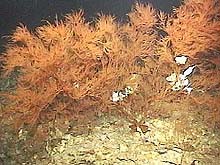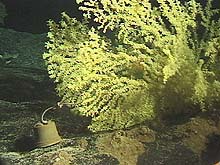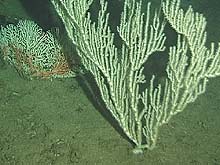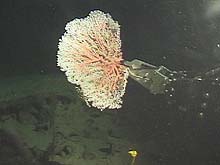
A black coral tree, Antipathes grandis, with attached oysters that are often found on this species. (Source: HURL Archive.) Click image for larger view.
Precious Corals
Frank Parrish, Fisheries Biologist
National Marine Fisheries Service
Honolulu Laboratory
Most people associate the word “coral” with reef- building animals in the phylum Cnidaria that secrete an exoskeleton of calcium carbonate (CaCO3). In addition to these “hard corals,” the word is also used to describe two other groups of cnidarians that do something very different.
The “soft corals” (alcyonaceans) produce internal CaCO3 spicules -- small, needlelike support structures that are embedded in their tissues. These spicules provide support while keeping the animals soft and flexible. Soft corals are residents of reefs but are not major contributors to the rocky material forming the reef structure.
The second group, called “precious corals,” are deeper-water, branching cnidarians that have been used for thousands of years to make beautiful beads, idols, and expensive jewelry. Interestingly enough, this group secretes an endoskeleton that is considerably harder than the exoskeletons of the so-called hard corals.

A gold coral tree, Gerardia sp., with a flower pot deployed by the Pisces V submersible to mark its location. (Source: HURL Archive.) Click image for larger view.
Protein, Calcite, and a Parasite
There are four types of precious coral in Hawai‘i: black coral (Antipathidae), gold coral (Parazoanthidae), red or pink coral (Corallidae) and bamboo coral (Isididae). Each of these has a different internal skeleton. Red and pink corals produce a calcite skeleton similar in hardness to ivory and pearls. Bamboo corals, on the other hand, produce a skeleton composed partially of calcite and partially of protein that is similar to the keratin in your fingernails. These alternating bands of material resemble a bamboo stalk; thus the corals' name.
Black and gold corals secrete only protein and no calcite. In addition, gold coral is a parasite, whereby its larval stages settle out on other species of corals, particularly bamboo corals. Eventually, the gold coral overgrows the entire bamboo “tree,” incorporating the bamboo coral's skeleton as the core of its own skeleton. Gold and bamboo corals also have another interesting characteristic: They are bioluminescent. These corals light up in a beautiful show of sparkling blue lights when mechanically stimulated, such as when the current is strong or when a crab walks down one of their branches. Perhaps it attracts the small animals they feed on; no one really knows for sure.

A bamboo coral, Keratoisis sp., showing characteristic banding pattern. A pink coral, Corallium secundum, is also shown (left). (Source: HURL Archive.) Click image for larger view.
Harvesting Methods
Precious corals have been harvested in a number of ways. For centuries, fishermen dragged nets over the sea floor, which broke and entangled the coral trees so they could be hauled into a boat. Because this method can impact other marine life attached to the sea floor, dredging and drag netting are now banned in the United States. The nation's precious corals are harvested by permit and only with selective methodologies.
In Hawai‘i, black corals are found in 100-300 ft of water, shallow enough to harvest using scuba equipment. Many harvesters, however, have died in pursuit of coral trees at the deep end of this range. Red, gold and bamboo coral are found between 1,000 and 1,500 ft; harvesting is conducted with remotely operated vehicles (ROVs) or submarines.

A pink coral, Corallium secundum, being collected for genetic analysis. (Source: HURL Archive.) Click image for larger view.
An Important Habitat
Beds of precious corals create habitat for a variety of fish and invertebrates. Oysters and sponges are commonly found attached to black coral trees. The long-nose hawkfish, Oxycirrhites typus, is often perched in the branches as well. Its body coloration is almost a perfect match to these corals, rendering it very difficult for both predators and prey to see. Deep-water eels and galatheid crabs are found in gold coral trees, while stalkless crinoids (e.g., sea lilies, feather stars) are frequently observed holding onto red and pink corals. This behavior gets them off the bottom and presumably allows them to capture prey more efficiently. Fully understanding the communities associated with, and dependent on, precious corals is an objective scientists are currently striving to achieve.
Sign up for the Ocean Explorer E-mail Update List.




















